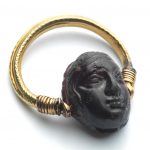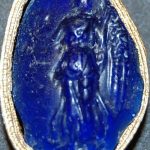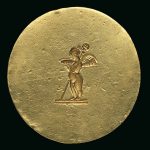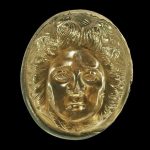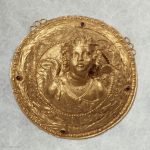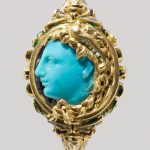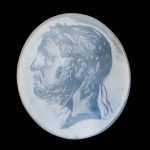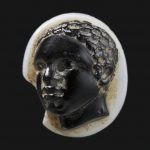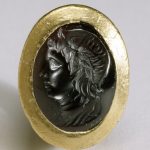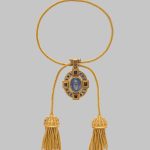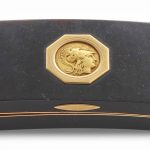Information on Hellenistic cameos. The Hellenistic period covers the period of Mediterranean history between the death of Alexander the Great in 323 BC and the emergence of the Roman Empire as signified by the Battle of Actium in 31 BC and the subsequent conquest of Ptolemaic Egypt the following year. The Ancient Greek word Hellas (Ἑλλάς, Ellás) is the original word for Greece, from which the word “Hellenistic” was derived. Reference: Wikipedia
The practice of carving cameos was introduced by the Greeks in the fifth century BC, and with the emergence of the Hellenistic kingdoms after the death of Alexander the Great, master craftsmen set up workshops in the cities of these new empires, such as Antioch. The most noted cameo carvers were based in Alexandria and patronised by the Ptolemaic court. Reference: Live Auctioneers.
A Hellenistic garnet cameo of a head The oval cabochon garnet depicting the features of a man, cut from an older 4th century BC scarab, within a later gold swivel mount, ring size O, length 15mm, width 11mm
The earliest cameos were created by carving the backs of Pharaonic stone scarabs; the scarabs were sometimes centuries older than their carvings. This is a good example of the type.
Sold for £4,750 inc. premium at Bonhams in 2014
A GREEK GOLD FINGER RING HELLENISTIC PERIOD, CIRCA LATE 4TH CENTURY B.C. Bezel: 1 in. (2.5 cm.) diam.; ring size H (US size 4)
Sold for GBP 40,000 at Christies in 2017
Greek Hellenistic Medusa Cameo
2nd-1st century BC. A large oval cameo of smoky quartz displaying the head of the Gorgon Medusa in high relief studied by Professor Dr. Bernhard Overbeck of Staatlichen Münzsammlung Munich (Hellenistic period, later Augustus); finely carved facial features and eyebrows, abundant hair twisted and formed into wavy locks flanked by wings to the temples; snakes beneath the chin forming a Herculean knot; in an old silver mount.
Accompanied by a French export licence and an exposé by Professor Dr. Bernhard Overbeck. This cameo, according to Dr. Bernhard Overbeck, can be compared stylistically an amethyst in the Colonna collection in Rome, and a sardonyx in the Hessisches Landesmuseum Darmstadt. Professor Overbeck comments that this cameo bears many similarities to the Medusa head on the underside of the Tazza Farnese, a sardonyx cup that was carved in Alexandria in the second century BC to celebrate the marriage of Ptolemy VIII to Cleopatra III. Ancient methods of hardstone carving were based on principles that are still used today. The pieces were worked by manipulating various drills against them. The actual cutting was accomplished not with the point of the drill itself but by using the drill to rub powders into the stone. Hellenistic cameos are almost exclusively made from sardonyx and so this piece, being in smoky quartz, is a very rare example. In style Hellenistic cameos, as well as intaglios, exhibit in miniature the qualities of Hellenistic sculpture. They continue and develop the styles of earlier artists, such as Praxiteles, in the softness of the features, but also a passion and pathos that is seen in Lysippus and Scopas, both noted sculptors of the Hellenistic period. Pathos is most clearly depicted in the Medusa images of this time, as seen on this cameo, and the Tazza Farnese. This cameo displays the soft lines and crisp carving associated with Hellenistic court artists and Professor Overbeck is in little doubt as to the dating of this piece to the Hellenistic period due to the composition of the hair and the rendering of the wings and snakes; Medusa heads from later periods tend to be different and of a simpler design. He also notes similarities to an amethyst cameo from the Colonna Collection in Rome, which is also dated to the Hellenistic period and is comparable in its details and composition. Although somewhat stylised, the facial features of this cameo do suggest portraiture, and it is possible that the cameo depicts either Berenike II or Arsinoe II, both popular subjects for cameos, such as the amethyst cameo of Arsinoe II now in the Walters Art Museum
Sold for £15,000 at TimeLine Auctions Ltd. in 2016
This rich gold medallion is proof of the quality and inventiveness of the Oriental workshops during the Hellenistic period, which was one of the richest in the history of Greek goldsmiths. The piece was probably originally part of an ornamental headdress made in around 250-200 BC. It is decorated with rinceaux and a wreath of foliage set with garnets. In the center, against the backdrop of foliage, is a high-relief winged bust of Eros, the god of love, wearing a crown of vine branches.
The edge of the medallion is decorated with a wreath of foliage, a strip of beading, and acanthus rinceaux, together with flowers and stalks of wheat, forming a backdrop of vegetation to the high-relief bust in the center of the medallion. The winged bust of the youthful god of love, Eros, has a round, chubby-cheeked face. He is wearing a crown of vine branches. The repoussé likeness of the god anticipates the figures in relief that Roman goldsmiths would use to decorate the inner surfaces of their silver tableware a few centuries later. It also heralds the decorative style known as imago clipeata, which, in terms of sculpture, refers to the practice of placing a portrait in relief within a round shield or other circular base. Numerous examples can be found on Roman sarcophagi dating from the Imperial era.
Reference:The Louvre
Cameo ring possibly of Alexander the Great mid-16th century; cameo: early Hellenistic 4th century B.C. This vibrant carving has previously been described as made of glass and as a product of the French Renaissance, but it is in turquoise, a rarity in cameos of any period. That it is reputed to have been in the Este collections may make an Italian origin likelier. It is not to be ruled out even that the stone is Hellenistic, from as early as the fourth century B.C., but the heroic type of Alexander the Great’s profile was adopted by various Hellenistic successors. In any case, the person who caused it to be set surely thought of it as ancient and as representing Alexander. It is probably a fragment whose broken edges the goldsmith has deftly concealed by forming the bezel as a lion skin, a motif that Alexander borrowed from Hercules.
Reference: The Metropolitan Museum of Art
Oval gem with head of Hellenistic ruler Greek Hellenistic Period Late 3rd–early 2nd century B.C.
Intaglio. Head of a man (possibly of Philip V or Nabis of Sparta), in profile to the left. He is bearded, but with a clean-shaven upper lip. He wears a laurel wreath, with the ties down the back of his neck. Deeply carved.
Reference: Museum of Fine Arts Boston
A Hellenistic Glass Cameo, circa 1st Century B.C. in two layers of white and black glass imitating onyx, cast in high relief with the head of an African boy facing three quarters to left, with finely modeled features and hair arranged in rows of circular curls. Height 11/16 in. 1.8 cm.
Sold for 6,600 USD at Sothebys in 2006
Ring with Dionysus
his massive gold ring has a convex bezel set with a garnet intaglio representing a young man crowned with an ivy wreath. This image could either be an image of the wine-god Dionysus or a portrait of King Ptolemy IV Philopator (221-204 BC) in the guise of this deity.
Reference: The Walter Art Museum
